QC35-II
back to Bose
back to measurements
home
published: May-15-2019
NO SMOOTHING is applied to the shown plots. Most measurement sites have some smoothing applied which ‘irons flat’ sharp peaks and ‘wiggles’. I do not use smoothing because some info about sound quality is lost when plots are smoothed.
Aside from a small correction of the microphone itself also some correction in the lowest frequencies is applied to the plots to compensate for the perceived loss of bass when using headphones. This is described HERE in more detail.
A ‘horizontal‘ frequency response curve on the shown frequency response plots on this website thus indicates a perceived ‘flat’ tonal signature.
ALL measurements are made with a good SEAL on a flatbed measurement rig.
The shape of your head, bone structure, pad size, pad ‘softness, (compliance), hair or no hair and or wearing glasses may (drastically) change the frequency response of some headphones, so… your personal experience may differ substantially from these plots.
Frequency response (tonal balance) is the most sound-determining aspect of headphones. A horizontal line shows audible neutral response in the plots on this website. Deviations in different severities at different frequency bands have an effect on the sound character.
The bigger the deviation the stronger the effect.
Below an aid to help determining the sound character of headphones with relation to the frequency response.

Bose Quiet Comfort 35-II
(noise cancelling)
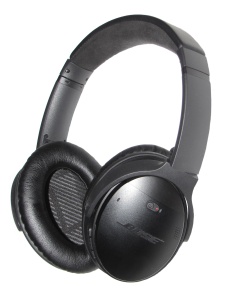 The Bose QC35-II (Quiet Comfort) is a noise cancelling headphone which is particularly suited for travelling by plains, trains and automobiles. The noise cancelling function works quite well for blocking out low frequency noises such as hum from engines, computer fans, airco etc.
The Bose QC35-II (Quiet Comfort) is a noise cancelling headphone which is particularly suited for travelling by plains, trains and automobiles. The noise cancelling function works quite well for blocking out low frequency noises such as hum from engines, computer fans, airco etc.
It basically is a QC35 with added functionality (action button)
Warning: There are fake QC35-II models on the market. Beware when you want to buy this headphone and buy from official Bose dealers only.
A bit about Noise Cancelling
The way Noise Cancelling works is by using a microphone inside each cup.
That (small electret) microphone signal is amplified. This is the reason/cause for the audible noise that can be heard during silence or very soft passages in most NC headphones.
The better (read lowest noise) the microphone and microphone pre-amp are the less audible noise there will be with N.C. on.
Fortunately the Bose QC35-II is one of the best performing NC headphones in this specific area (low self noise in quiet passages).
The microphone inside the cup ‘listens’ to ALL sounds in the ‘ear chamber’ and thus picks up the music playing AND the, attenuated by the pads and cups, outside noises as well.
There are also microphone(s) on the outside of the cups but these do nothing for the Noise cancelling and are solely there for taking/making calls.
The Noise Cancelling trick works as follows.
The ‘inner microphone’ listens to what is ‘heard’ inside the cups and compares this to ‘silence’.
It then applies the ‘opposite’ signal to the driver in order to make the final result ‘silence’.
This is as good as ‘instant’. Audio is a very ‘slow’ signal for electronics.
So if the microphone picks up sounds that should not be there the opposite signal is applied to the speaker.
That’s what the Noise Cancelling circuitry inside ‘aims’ for.
of course this isn’t ‘perfect’ as only sounds near the microphone are compensated (for a big part). This only works for lower frequencies because phase differences become a problem due to the speed of sound and the wavelengths of these frequencies.
Instead of total silence we want to listen to music. The applied music signal is added to the ‘reference silence’. This way the music signal IS now the ‘reference’ to which the N.C. circuit aims for.
The microphone ‘measures’ the acoustical signal inside the cups and compares that to the applied music signal. When the headphone driver/acoustics itself ‘colours the sound’ or outside noises enter the cups the microphone + N.C. circuit corrects the ‘errors’. Not only the unwanted outside noises are attenuated (by applied anti-sound) but also the reproduced audio is a LOT closer to the actual applied signal.
This can easily be seen in the frequency and distortion plots further down this article.
It actually works the same as ‘Motional Feedback’ in speakers.
The better (the more linear in FR and less distortion) there is from the driver, the less ‘compensation’ is needed as well.
In the end, N.C. attenuates (not removes completely) outside noises and the added bonus is the acoustical music signal is a closer ‘copy’ to the applied electrical music signal.
Some manufacturers apply a small tilt or bass boost.
QC35-II
The QC35-II sells between € 300.- and € 350.- but sometimes one can find one cheaper as well. This is the TOTL model from Bose.
It isn’t feature packed like the Sony WH1000X-M3 the QC35-II is very easy to operate though.
Where the QC25 works on a single AA battery the QC35-II works on an internal and non-replaceable 500mA/h Lithium battery that is charged through an micro-USB port.
This will give you around 20 hours of usage on a fully charged battery (using NC)
This means that after a few years of usage one either faces costs or needs to replace the headphone. Charging should be about max 2 hours, so it charges pretty quickly.
There is also a little LED indicator which also shows the battery charge state and level.
The USB cable is very short (30cm) so while charging the headphone cannot be used.
Fortunately the QC35-II can also be used with the device switched off using the 3.5mm TRS cable. The sound quality is still surprisingly good and attenuation is also quite decent when working as a ‘normal’ closed headphone.
When in BlueTooth mode(4.1) the NC is default ‘on’. On start up it tells you (speaks to you) telling you the battery charge and the device(s) it is attempting to connect to.
The QC35-II can speak to you in: English, German, Korean, Swedish, Spanish, Mandarin, Italian, Dutch, French, Japanese and Portuguese.
One can control the phone it is connected to (Audio/Video Remote Control Profile (AVRCP)) and adjust the volume, pause, skip, rewind etc. with buttons on the right cup. Take (or refuse) incoming calls and even manage 2 active calls.
On the left cup there is a single function button which can be set to either disable NC or activate google assistant. A small LED indicator gives info about BT functionality.
Connecting can be done using the Bose app, NFC or in the ‘normal’ manner.
I did not test B.T. functionality, this has been covered by other reviewers.
The QC35-II has more than 1 microphone outside of the headphone which feeds back your own voice when taking calls (so you don’t scream into your phone) and has a special arrangement so the microphone sounds properly even in windy conditions.
The headphone has fairly small cups but will fit most head and ear sizes. Probably not all head/ear sizes though. The comfort is quite high and the QC35-II can be worn for hours.
The pads are soft (memory foam) and feel pleasant. A disadvantage of these very soft pleather (vinyl covered cloth) pads is that they will flake after many hours of usage.
Pads can be replaced so isn’t an issue. The clamping force is pleasantly low yet doesn’t fall off ones head when moving around/jogging.
The headband also is very soft (Alcantara covered foam) and doesn’t press down hard on the head.
The efficiency is quite high so it already plays pretty loud directly from a phone, even in passive mode. A price one has to pay for this is the low power rating of the headphone.
20mW is a very low value and means the drivers can easily be destroyed (burnt out) when connected to more powerful desktop gear while playing loud. When it is lying on a desk for instance and one turns up the volume by accident the drivers may already be toast. Seeing quite a few complaints and videos online that show how to exchange blown drivers tells me this can be issue.
The supplied 2.5mm TRS to 3.5mm TRS cable (for connecting it with 3.5mm sources that do not have a BT connection) is 1.2m long and is a bit microphonic. This improves very slightly in N.C. mode.
specifications:
Type: Over ear, closed, Noise Cancelling, Bluetooth
Usage: Home, portable
Driver type: dynamic
Pads: replaceable, pleather, fast memory foam
Internal pad dimensions: height: 60mm, width: 40mm, depth: 16mm front, 28mm back
Collapsible: yes and can fold flat.
Headphone connector: 2.5mm TRS
Cable entry: single sided (left side)
Cable: replaceable, 1.2m with gold plated 3.5 mm TRS plug
Driver size: 40mm Ø
Nom. power rating: 20mW
Max. voltage: 1V
Max. current: 25mA
Max. S.P.L.: 118dB
Impedance: driver itself = 32Ω
Impedance (passive mode): 40Ω + 47μF in series (wired mode only).
Impedance (active mode): 480Ω + 47μF in series (wired mode only)
Efficiency: (passive mode) 99dB @ 1mW
Sensitivity: (passive mode) 118dB @ 1V
Sensitivity: (active mode) 115dB @ 1V
profiles: A2DP, HFP, HSP, AVRCP, BTLE
BT version: 4.1
Codecs: AAC, SBC
Weight: 234 gram
Colour: black
Clamping force: low
Accessories: airplane adapter, hard case, manual, 3.5mm cable, micro USB cable.
Sound description NC off (wired):
The overall sound is warm with a ‘fattish’ bass. Bass goes deep but is somewhat boomy and not ‘tight’. The mids have a decent clarity and a warm an ‘full’ character.
he sound is a bit ‘laid-back’ as in subdued ‘Clarity/Presence’. This is a good thing when listening to popular music. The treble is pleasant and not sibilant at all. Treble quality is ; smooth’ but lacking in the finer nuances.
I don’t know if the QC35-II stops working in passive mode (some BT headphones do) when the battery is completely depleted but the QC35 is still very listen-able with BT/NC turned off and used passively (using the 3.5mm TRS cable). Some NC headphones can sound pretty poor with the NC off. This certainly is not the case here.
Sound description NC on (wired):
With the NC on the background noises disappear quite effectively. The tonal balance becomes more balanced. This means the ‘fattish’ bass now tightens up (and is slightly lower in level) and the mids loose some (but not all) of the ‘warmth. Treble is less subdued and clarity is improved somewhat. The treble is still ‘nice’ and ‘soft’.
Overall a quite pleasing tonal character which sounds ‘good’ already at lower listening levels. Bass is ‘realistic’ and there is more ‘clarity/presence’. Treble quality doesn’t change much but is relatively slightly subdued. The sound quality of BOSE headphones with the N.C. is quite good and almost exemplary.
Bass heads may like bass levels a bit better when the NC is switched ‘off’.
When I would have to nitpick I would say the stereo image is a bit on the narrow side and bass and lower mids are not as good as those of the better open headphones but definitely better than most other BT and NC/BT headphones. Treble, while soft and smooth lack ‘finer resolution’ but don’t sound harsh/sibilant.
measurements
Below the frequency response of this headphone with the power switch ‘OFF‘

Yes, that’s quite a ‘bump’ between 60Hz and 200Hz reaching a good +10dB. This is the range of ‘bloated/muddy’ bass.
It sounds darker when switched off, voices are still ‘clear’ though (due to the peak around 1kHz) . The treble is soft but still present but does not sound rolled-off or lacking ‘air’ in an obvious way.
When the headphone’s noise cancelling circuit is switched on the headphone ‘transforms’.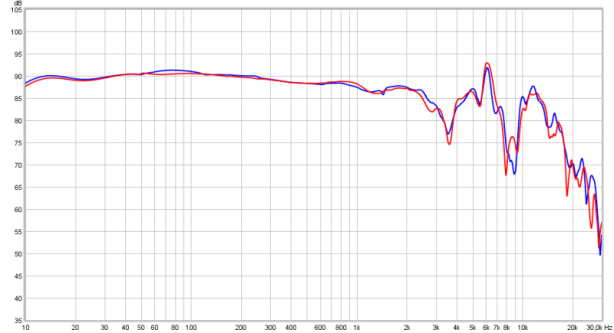 Reproduction from the deepest lows (below 10 Hz) to upper mids now becomes ‘balanced’ tilted slightly towards the warmer side of things (approximates ‘room’ curves). Clarity improves. A quite balanced sound, certainly at lower listening levels.
Reproduction from the deepest lows (below 10 Hz) to upper mids now becomes ‘balanced’ tilted slightly towards the warmer side of things (approximates ‘room’ curves). Clarity improves. A quite balanced sound, certainly at lower listening levels.
Because of the noise cancelling properties it doesn’t have to play loud anyway even when there are plenty of ambient sounds.
The treble, while tonally quite pleasant, and hifi-ish sounding still ‘lacks’ somewhat compared to more hi-fi oriented headphones. It does sound ‘smooth’ yet lacks the finer nuances top headphones are able to produce. Still, the quality is more than high enough to enjoy music while travelling.
Below the difference one gets when the QC35-II is switched ‘off‘ and switched ‘on‘.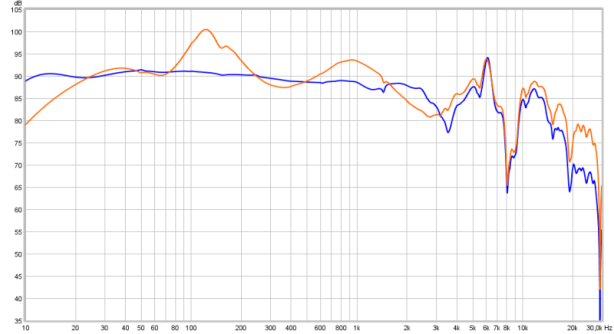 As can be seen, everything below 3kHz improves dramatically. The ‘jagged’ treble response is an indicator of the ‘somewhat lesser quality treble’.
As can be seen, everything below 3kHz improves dramatically. The ‘jagged’ treble response is an indicator of the ‘somewhat lesser quality treble’.
compared to QC25
Below the QC25 versus the QC35-II in passive mode. These headphones are clearly ‘related’ but not exactly the same. The QC25 has a gew dB more lows and less ‘forward’ mids (1kHz) and a lot less treble than the QC35-II in passive mode.
These headphones are clearly ‘related’ but not exactly the same. The QC25 has a gew dB more lows and less ‘forward’ mids (1kHz) and a lot less treble than the QC35-II in passive mode.
 Above the QC25 versus the QC35-II in N.C. mode. The differences are a lot smaller now.
Above the QC25 versus the QC35-II in N.C. mode. The differences are a lot smaller now.
The QC35-II has slightly more clarity (4-6kHz) and a bit more ‘sparkle’ in the treble.
Both headphones show a typical B&K curve which is how ‘flat’ measuring speakers (in anechoic conditions) measure when used in a proper conditioned listening room.
i.e. a slightly downward sloping response.
So close in tonal balance to how speakers in a room would sound.
Seal
Closed headphones usually depend on a good seal (pads sealing off properly all around the ear) to get a good subbass response. This headphone is not different here. At least not in passive mode. Below the QC35-II in passive mode measured with a perfect seal, while wearing thick armed (reading-/sun-glasses) and with the seal broken.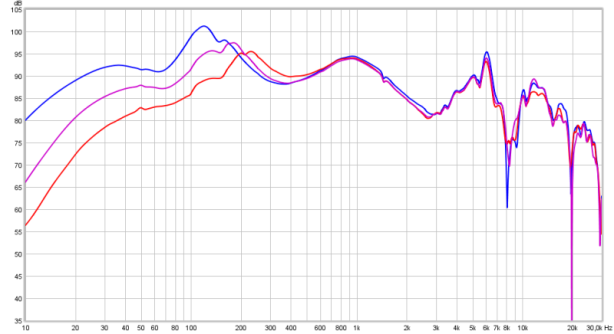 As can be seen to get the proper amount of bass a good seal is important in passive mode (switched off). Even with glasses on the response is still pretty good (maybe even a bit better) but when the seal is broken a bit more the lower bass suffers.
As can be seen to get the proper amount of bass a good seal is important in passive mode (switched off). Even with glasses on the response is still pretty good (maybe even a bit better) but when the seal is broken a bit more the lower bass suffers.
In N.C. mode the lower bass roll-off is mostly compensated for by the Noise Cancelling which effectively works as motional feedback.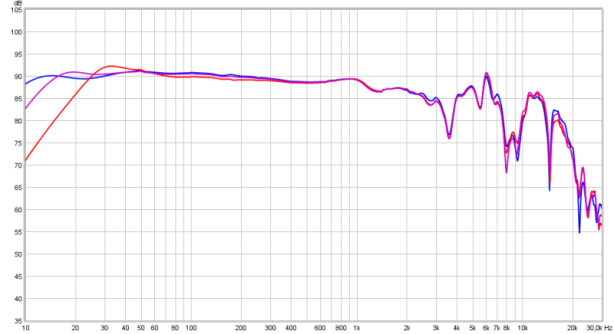 Bass extension is not affected when wearing glasses and even a substantial seal breach doesn’t affect the tonal balance but will increase distortion and possibly even over-drive the low power drivers as the built in amplifier will pump in 10x more power in the lower bass to compensate.
Bass extension is not affected when wearing glasses and even a substantial seal breach doesn’t affect the tonal balance but will increase distortion and possibly even over-drive the low power drivers as the built in amplifier will pump in 10x more power in the lower bass to compensate.
damping factor/output resistance (passive mode only)
A higher output resistance from an amplifier can affect the tonal balance of a headphone. This is dependant on the impedance of the driver as that can vary depending on frequency.
In this case there is something else going on as the driver is not directly connected to the headphone plug but is coupled via a capacitor and extra resistor. This is needed as N.C./BT headphones have an internal amplifier and in passive mode the speaker must be ‘isolated’ from that amplifier.
Of course the plots below are only valid when connected directly to an amplifier using the 3.5mm TRS plug. When using a BT connection this all isn’t applicable.
Below the effect of a 120Ω +output resistor is shown versus 0Ω amplifier. The lower frequencies aren’t attenuated much but the higher frequencies become the higher the attenuation is as well. The attenuation at 2kHz (and up) is 12dB.

Below the same plot but overlaid at 2kHz. This shows the increase in bass is substantial due to voltage division. At 20Hz there is 10dB more sub-bass (≈ an acoustical doubling) In active mode(N.C. on) this doesn’t happen any more as the input impedance of the internal amplifier is 480Ω and mostly resistive. The overall amplitude just drops 2dB, which is compensated in the plot below, to better show the tonal balance is not affected.
In active mode(N.C. on) this doesn’t happen any more as the input impedance of the internal amplifier is 480Ω and mostly resistive. The overall amplitude just drops 2dB, which is compensated in the plot below, to better show the tonal balance is not affected.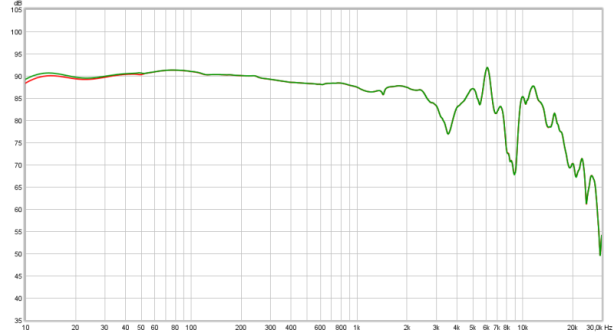
In bluetooth mode the output resistance of the source thus doesn’t matter.
Below the distortion plot of the QC35-II with the power switch in the off position. Below the same plot but shown in percentage scale.
Below the same plot but shown in percentage scale.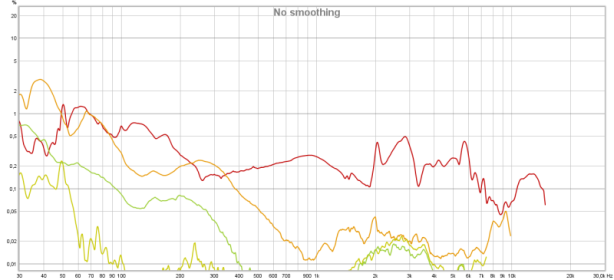 Small drivers usually show an increase in distortion at lower frequencies. The QC35-II in passive mode is no exception. Below 200Hz the 2nd harmonic distortion increases to 1% at around 60Hz. This is not exceptionally high though at 90dB SPL (is not the same as 90 Phon). The higher 3rd harmonic distortion points towards ‘compression’.
Small drivers usually show an increase in distortion at lower frequencies. The QC35-II in passive mode is no exception. Below 200Hz the 2nd harmonic distortion increases to 1% at around 60Hz. This is not exceptionally high though at 90dB SPL (is not the same as 90 Phon). The higher 3rd harmonic distortion points towards ‘compression’.
Overall the distortion is pretty low.
The distortion in the mids will most likely be below the shown 0.2% as this is the measurement limit of my measurement system.
Below the distortion plot of the QC35-II with the Noise Cancelling on (percentage scale only).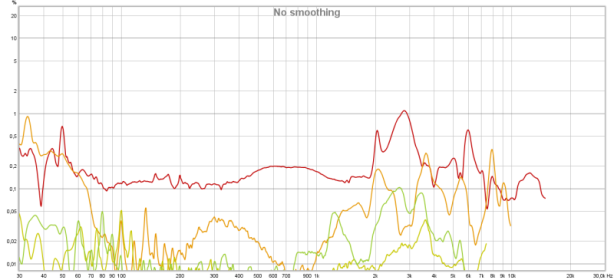
Distortion in the bass area is impressively low, this is due to the ‘Motional Feed-Back’ effect of the Noise Cancelling circuit. Bass is good and clean sounding. Distortion (at low to normal listening levels) is as good as that of most orthodynamics. The higher distortion levels between 2kHz (the maximum frequency for the NC circuit) is a bit high.
In this part of the frequency range the ear is most sensitive as well so 1% distortion is more audible here than 1% at lower frequencies. The better headphones have much lower distortion levels above 1kHz.
Below the CSD (Waterfall plot) of the QC35-II in passive mode.
Right and Left channel are superimposed. At 500Hz there is a substantial amount of energy ‘lingering’ on which results in less defined and somewhat coloured lower midrange. Above 2kHz some short lived resonances are visible. Nothing to worry about though.
At 500Hz there is a substantial amount of energy ‘lingering’ on which results in less defined and somewhat coloured lower midrange. Above 2kHz some short lived resonances are visible. Nothing to worry about though.
Below the CSD (Waterfall plot) of the QC35-II with the N.C. on.
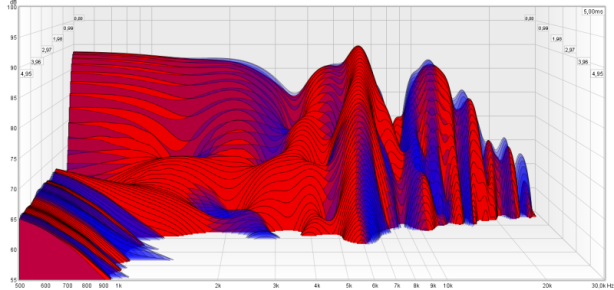 The mids are much better controlled now and clarity has improved. Here we can see the blessings of the N.C. circuit below 2kHz.
The mids are much better controlled now and clarity has improved. Here we can see the blessings of the N.C. circuit below 2kHz.
Another form of looking in the time domain is the spectrum plot. The amplitude is colour coded and both the time scale and frequency scale differ as well.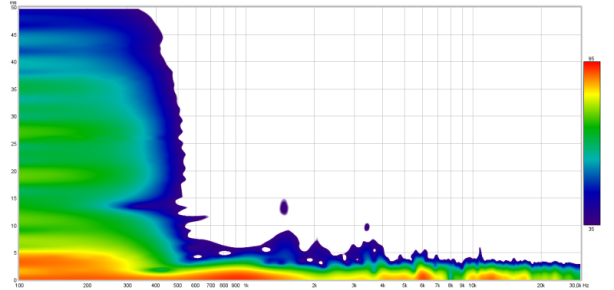 In passive mode the lingering below 2kHz is visible. Below 500Hz the frequencies linger on longer than desirable.
In passive mode the lingering below 2kHz is visible. Below 500Hz the frequencies linger on longer than desirable.
Below the active mode. The lingering between 400Hz and 2kHz is gone. Below 400Hz the bass response is much improved as well.
The lingering between 400Hz and 2kHz is gone. Below 400Hz the bass response is much improved as well.
Below the step response with a dB scale (so not similar to an oscilloscope plot). In passive mode and with N.C. on.
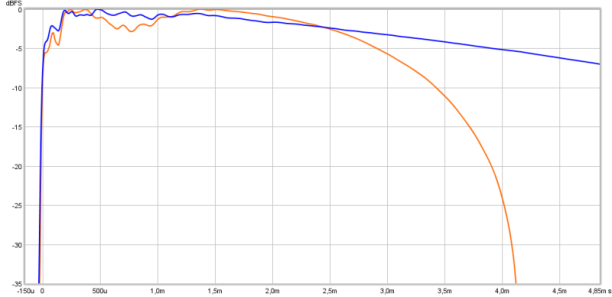
In active mode the initial rise is higher and there is no overshoot. Bass extension is exemplary (N.C. on) and the tonal balance is excellent (almost flat horizontal line after the rising edge. The fact that the edge does not reach the 0dB line is indicative for the lack of upper treble extension/’air’ and shows the treble to be ‘soft’ and ‘somewhat subdued’.
In passive mode (switched off) we can see that the initial rise is a bit lower. The small ‘peak’ below 500μs is indicative for the ‘forward’ mids. The drop of the horizontal line preceded by the ‘hump’ around 1.5ms is indicative for the bass being a bit ‘wooly’ as in not well defined/tight and somewhat ‘overdone’.
conclusion
The tonal balance and sound quality of this headphone is very good. Also comfort is very good. Then there also is the wireless connection and the excellent working Noise Cancelling feature. What’s not to like here ? This is a good sounding headphone with a very enjoyable sound.
At around € 250- € 300 there are some ‘better sounding’ headphones around but the Noise Cancelling feature and the increase in sound quality when it is ‘on’ makes it an excellent headphone for travel purposes. Maybe even one of the best at this price point.
Are there downsides ? It is battery charge dependent and needs to be recharged using an USB power source. The charge cable is very short so you can’t use it while charging.
The power rating of the drivers is very low so one has to be very careful when connecting the QC35-II to an external amplifier in passive mode ! Broken drivers do seem to happen.
Another downside is the non user replaceable battery which after a few years of usage will certainly crap out on you. Having the battery replaced by a technician will be costly.
The last downside are the pads which will flake sooner or later (depends on usage and skin type) but are replaceable (unlike the internal battery).
Warning: There are fake QC35-II models on the market. Beware when you want to buy this headphone and buy from official Bose dealers only.

Really appreciate all these details, as Bose doesn’t provides anything at all, and technical details aren’t available not even internally in the company -at least based on input from Pro area Bose members.
Would like to check if you could recommend some specific models of DACs, as I’m not quite sure which model delivers enough power to support this headphones, and moreover, which one won’t damage it.
I suppose you mean a DAC/amp dongle. One that has 3.5mm TRS output jacks.
All of these will be able to reach 1V so can easily drive the QC35.
The QC35, especially in active mode, draws almost no power at all. It uses the amp inside the QC35.